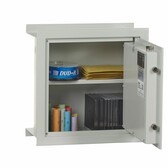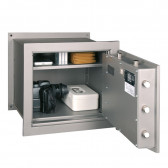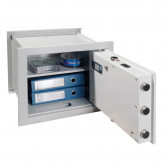A wall-mounted safe is one of the most sensible solutions for locating a home version of this type of device. It is best to plan its installation already at the stage of house or flat construction. Renovations will also be a good excuse to think about a safe. So where is it best to place a safe within your own four walls?
A safe in the wall, but which one?
Installing a safe in the wall is not as simple a matter as you might think. It is not enough to simply cut a hole in such a surface. It is best to plan the location of the device already at the stage of designing the construction of the house, possibly during the renovation (although then we will be somewhat limited by the technical capabilities of the building). When installing a wall safe, we are limited by two issues:
1. the thickness of the wall (i.e. the possible depth of the safe),
2. the structural strength of the wall.
A wall safe should be installed in a load-bearing wall. However, in order to do so, it must first be adequately reinforced, so that if its structure is breached, the whole building is not damaged (that is why safes are usually placed in load-bearing walls if the building constructor included them in the design). Placing the device in a partition wall is also possible (provided, of course, that it is not a light wall made of plasterboard). The installation of a safe in a brick partition wall is performed much more frequently than the installation in a load-bearing wall during a building renovation. Unfortunately, installing a safe in such a place has its limitations. Due to the smaller thickness of the partition wall, either a rather shallow safe can be installed, or a suitable enclosure (in the adjoining room) must be created for it. This can be a fictitious pillar, filling a recess in the wall, or enlarging a wall fault.
Safes are attached to the wall with wall plugs, screws or anchors, and the free space between the wall and the wall of the device is poured with concrete (depending on the availability of space, the thickness of the concrete should be 10-15 cm). At the same time, when choosing a place for its assembly, one should think whether it will be exposed to flooding (and not only in the case of flooding, but also when, for example, in the wall, in the place above the safe runs the water and sewage installation).
Check our category of home safes
A safe in an unusual room
A wall safe is most often installed in a study or bedroom – this is also the place that most often comes to mind for a burglar. It is these rooms that he checks first. Therefore it makes much more sense to mount the safe in a room that is not so obvious – for example: in the boiler room, laundry room or even in a smaller hallway on the first floor. Of course, it should be invisible at first glance and in a discreet place – so that it cannot be seen for example by a neighbour through the window or if we feel the urge to open the safe and do not have to invite guests out of the room.
You may be interested in: Wall or floor safe – which one to choose?





